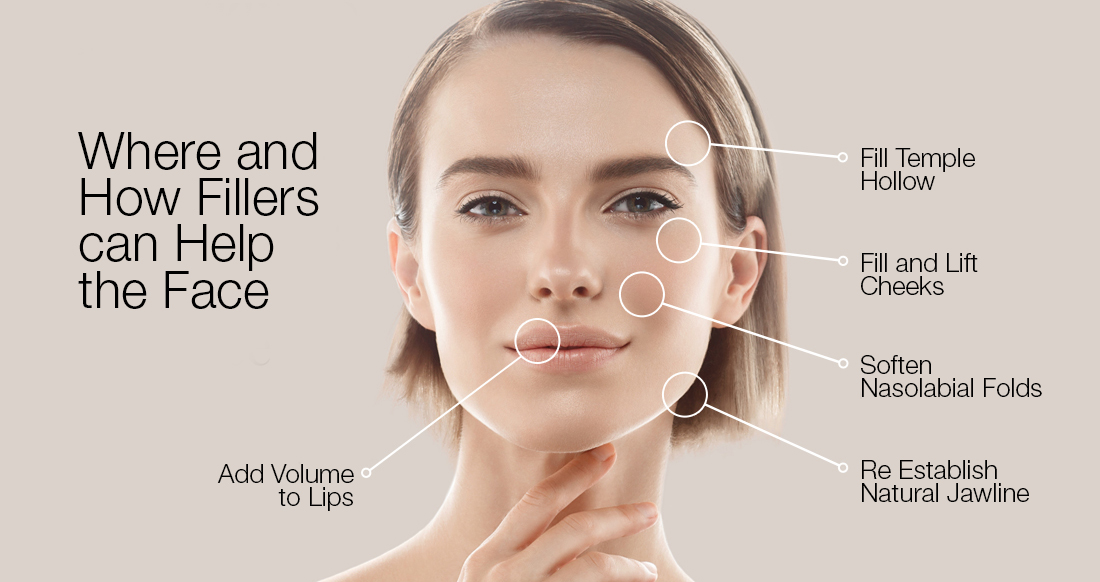Dermal Fillers


EVERYTHING WE NEED TO KNOW ABOUT FACE FILLERS
If you’re trying to find out, on the best treatment for the signs of ageing, chances are you’ve stumbled across dermal fillers. You’re probably aware of the basics; that these simple injections can be used to correct or enhance facial contours, plump up lips, soften the appearance of wrinkles and improve the tone, texture and hySo.
Learn about injectable dermal fillers
Did you know that many visible signs of aging can be traced back to volume loss? As facial tissues thin out, lines become etched around the nose and mouth and cheeks look a little hollow. Dermal fillers can replace lost volume to help smooth wrinkles, plump the lips, and restore a more youthful appearance. Learn all about injectable filler treatments below.
DERMAL FACE FILLER
When a practitioner advertises dermal fillers, they’re talking about a substance that can be injected into the face to improve its appearance. At around the age of 25, the body stops producing collagen and elastin, the two proteins that work together to keep tissue firm and skin elastic, and the existing collagen in the body begins to break down.
Without these two proteins, the body begins to display the typical signs of ageing (things like sunken cheeks, hollow eyes, deep lines and wrinkles) as the body no longer has a means of keeping tissue strong and skin supple.
Dermal fillers, the majority of which are made up of hyaluronic acid (a naturally occurring sugar chain molecule that attracts and binds water in the skin) can be used to work in harmony with the body’s remaining collagen and elastin, supporting these all-important proteins to give skin a more full and youthful appearance.

HOW LONG DO DERMAL FACE FILLERS LAST?
Dermal fillers can last anywhere between 6 to 18 months, depending on the type of hyaluronic acid used,the area of and as well as, how well it’s suited to the purpose and to the individual. There are over 200 different brands of hyaluronic acid available and your practitioner should be able to advise you on what’s right for you. But the most preferred brands are not more than a hand fingers.
ARE DERMAL FILLERS SAFE?
One of the reasons hylaronic acid fillers are so popular is because of their safety.Allergic reactions are nearly unheard of and infections are also extremely rare, as long as your injections are carried out by a healthcare professional with specialist training.
WHAT ARE INJECTABLE DERMAL FILLERS?
Dermal fillers are gel-like substances that are injected beneath the skin to restore lost volume, smooth lines and soften creases, or enhance facial contours. More than 1 million men and women annually have choose this popular facial rejuvenation treatment, which can be a cost-effective way to look younger without surgery or downtime.
SIDE AFFECTS OF DERMAL FILLER
Dermal fillers do come with some side effects which tend to occur immediately after injection, but these are usually temporary and disappear within a few days. According to the FDA, normal side effects include redness, swelling, bruising, itching and tenderness, but on extremely rare occasions more serious side effects requiring early management can occur.
To minimise risk with dermal fillers, it is very important the practitioner has had specialist training, and is using safe products correctly. Should unwanted effects occur, that practitioner should be able to manage them safely.
HOW CAN DERMAL FILLERS ENHANCE MY APPERANCE?
While dermal fillers are casually known as “wrinkle fillers,” they can do much more than just smooth out wrinkles, although they are excellent at this too! Here are a few of the common issues dermal fillers can help address:
- Smooth out lines around nose and mouth (a.k.a. marionette lines, smile lines, and parentheses)
- Enhance & restore volume to sunken cheeks or temples
- Diminish vertical lip lines
- Plump & enhance the lips
- Smooth out a chin crease
- Improve symmetry among facial features
- Nose asymetri and augmentation
- Temporal Groove correction
- Increase Ear lobe volume
WHAT ARE THE VARIETIES OF DERMAL FILLERS?
There are a variety of FDA approved filler products that cosmetic doctors use. In general, fillers are categorized by the substance they are made from. A note for your safety: always make sure that you are receiving FDA approved, brand name fillers, which are only available through a licensed physician.
HYALURONIC ACID FILLER
Hyaluronic acid is a naturally occurring substance that is already found in your skin. It helps keep skin plump and hydrated. HA fillers are typically soft and gel-like. The results are temporary, lasting 6 to 12 months or longer before the body gradually and naturally absorbs the particles. Most HA fillers are infused with lidocaine to help minimize discomfort during and after treatment. FDA approved HA fillers include:
- Juvéderm
- Artfiller
- Restylane
- Belotero
- Teosyal
CALCUM HYDROXYAPATITE (CaHA)
Calcium hydroxylapatite is also a naturally occurring substance, found primarily in our bones. When used in a filler, the calcium particles are nearly microscopic and suspended in a smooth gel. The consistency of a CaHA filler is typically thicker than that of a hyaluronic acid filler and typically last longer as well, about 12 months for most patients. Calcium hydroxylapatite is also reported to help stimulate natural collagen production, and it is typically used for deeper lines and wrinkles. FDA approved CaHA fillers include Radiesse®.
POLY-L-LACTIC ACID
Poly-L-lactic acid is a biocompatible (meaning it is safe to use in the body), biodegradable SYNTETHİC substance. It has been used for many years in medical devices, such as dissolvable stitches. Poly-L-lactic acid products are technically classified as “collagen stimulators,” as their main mechanism to smooth fine lines is by helping your skin rebuild natural collagen—the filler gel itself dissipates a few days after treatment. Poly-L-lactic acid is typically used to treat deeper facial wrinkles, and results can last more than 2 years. FDA approved Poly-L-lactic acid fillers include Sculptra® Aesthetic.
POLYMETHYLMETHACRALITE (PMMA)
Polymethylmethacrylate (PMMA) is a synthetic, biocompatible substance that has been used in medicine for much of the last century. In dermal fillers, PMMA takes the form of a “microsphere” or tiny ball, that remains beneath the skin indefinitely to provide continued support. PMMA fillers will also contain collagen, a naturally occurring substance in the skin that provides structure and firmness. FDA approved PMMA fillers include Bellafill® (formerly known as Artefill).
AUTOLOG FAT INJECTIONS (FACIAL FAT GREFTING)
Autologous fat injections are the only injectable filler treatment that requires surgery, but results can last for many years. Your own fat is harvested from another area (autologous means “from the same person”), typically using liposuction. The fat is then purified and injected into the face to help restore volume to the cheeks, temples, lower eyelids, or other areas. Fat injections require specialized training to perform safely and achieve great results, and should only be performed by an experienced, board certified cosmetic surgeon.
WHAT WE SHOULD CONSIDER WHEN CHOOSING A PROVIDER FOR FILLER TREATMENTS
When selecting a provider for injectable treatments, give your decision the same level of care and scrutiny that you would for a surgical procedure. Non-surgical filler treatment is still a medical procedure that requires specific training, knowledge and skill to ensure safe treatment and natural-looking results. Choose a provider with an extensive knowledge of facial anatomy, a well-developed aesthetic eye, and a surgeon’s skill and precision.
Whomever you choose, make sure your provider has a proven background in cosmetic medicine as well as training and substantial experience performing filler injections. Ask to see before & after photos of a potential provider’s patients.
WHICH FILLER DO I HAVE TO PREFER?
With so many dermal filler products on the market, it can be difficult to know which option is best for you without an experienced cosmetic surgeon’s guidance. Each product is uniquely formulated to have a certain texture, density, and injection depth, which means that certain fillers work better for certain areas of concern. While your provider will determine what product is best for you, the following diagram illustrates in general where cosmetic doctors tend to apply certain products:

 TR
TR





